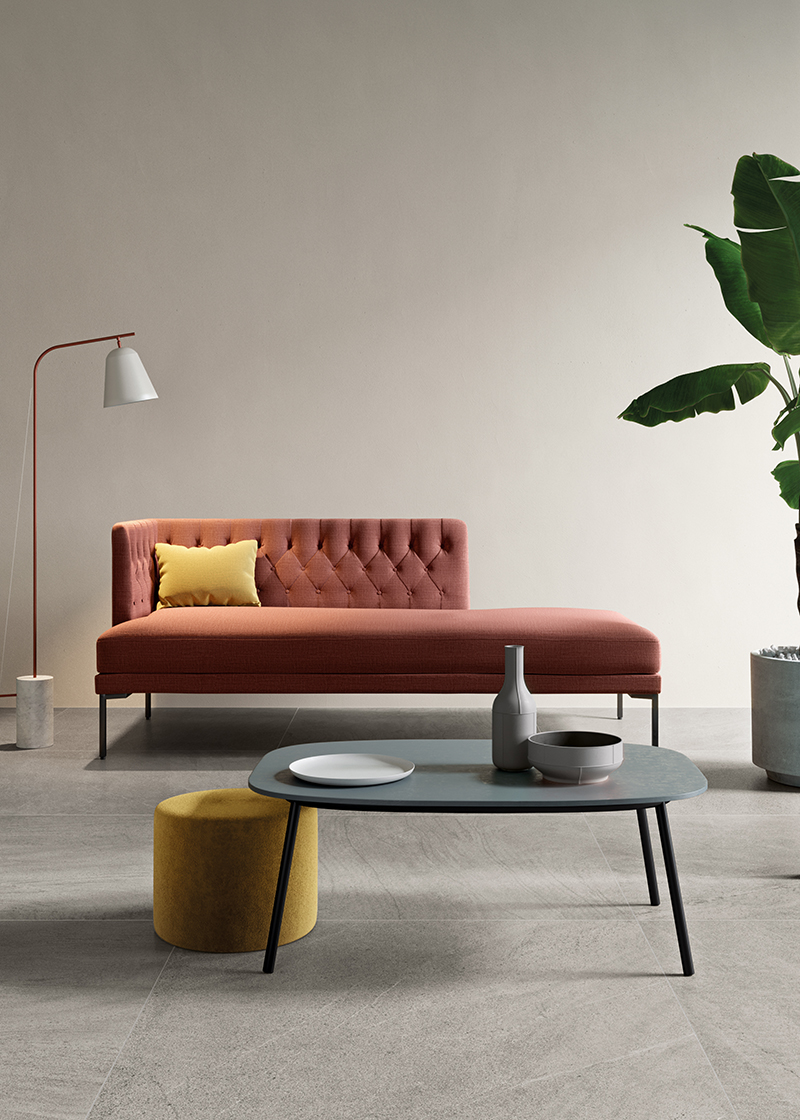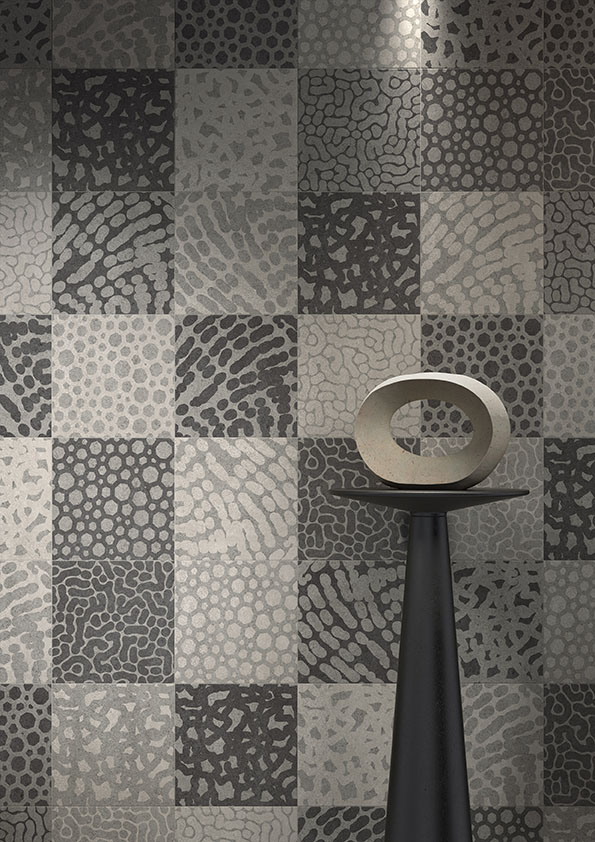Designing the Home of the Future: Minimalist-Chic Surfaces and Décor
First conceptualised in the mid-1960s in reaction to the extravagance of Pop Art style, minimalism is a total aesthetic movement, a trend that integrates art, literature, architecture, fashion, and design, yet also embodies a specific lifestyle: a sensibility driven by the desire to eliminate the superfluous and focus on the essential. As famously stated by architect and designer Mies van der Rohe, “Less is more”.
In all its interpretations, minimalism primarily encourages the awareness that an effective design is one which offers a simple solution to a complex need. In architecture, this translates into the careful selection of just a few quality elements and into the creation of linear and, above all, functional spaces.
However, designing minimalist rooms and décor does not mean creating a sense of detachment. On the contrary, the open and uncluttered spaces of a minimalist home are able to conjure cosy, intimate, and, in a certain sense, even spiritual atmospheres which, with the incorporation of chic or elegant details, acquire the warmth necessary to become truly inviting.
Stoneware surfaces, inherently inclined to have a simple texture, are perfect for creating environments with an austere and functional spirit, in keeping with a minimalist-style home; spaces that are peaceful and facilitate concentration, qualities that, particularly in today’s fast-paced lifestyle, become supreme values on which to base the design of the future.
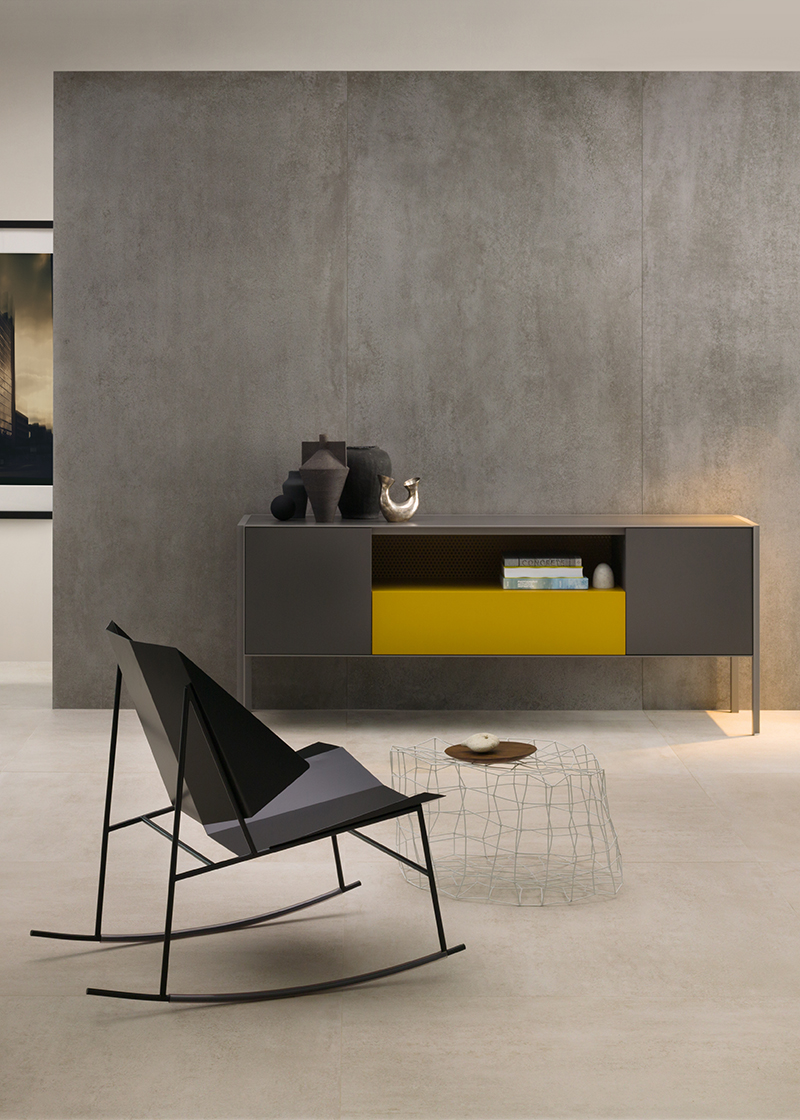
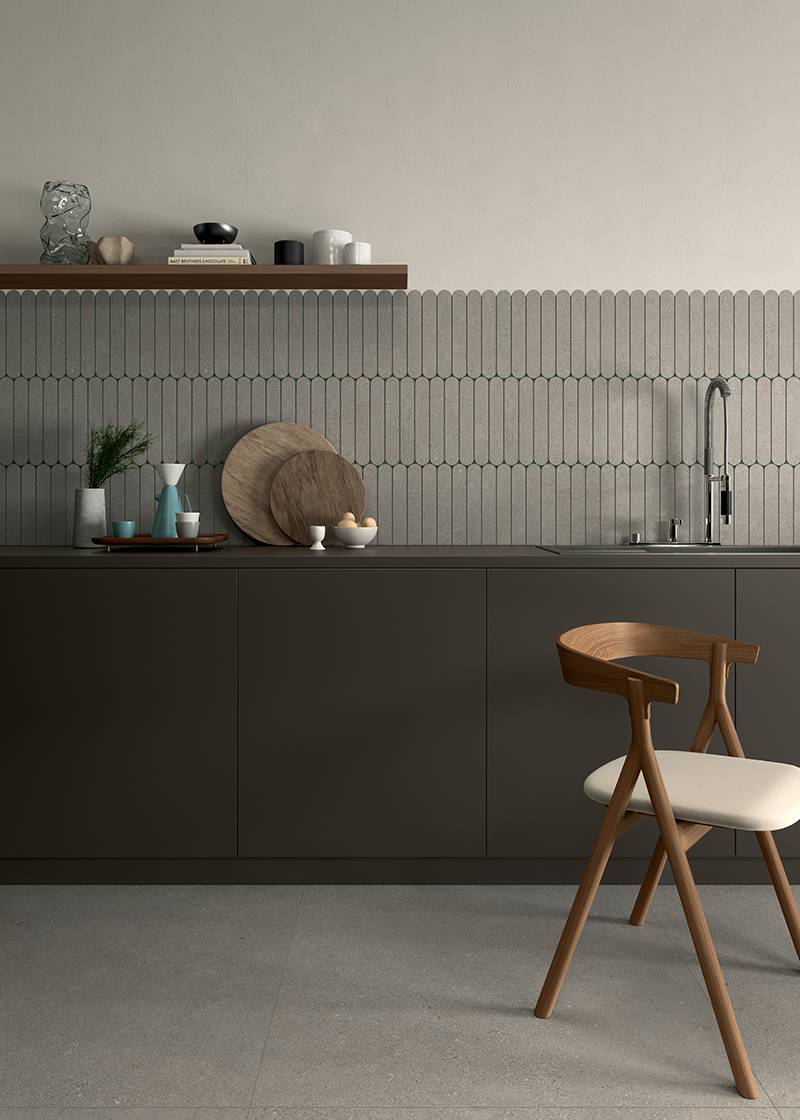
Less is More: a Minimalist Kitchen with Uncompromising Performance
Today the kitchen has become a gathering space, as much for residents of the home as for their guests. Here, in harmony with the entire living area, the ideal to strive for is the same: a clutter-free and visually unobstructed minimal-chic kitchen.
Sleek yet also angular, the layout is well-structured, with each function efficiently and practically fulfilled through carefully selected furniture. This design ethos translates into visual balance, through the consistent pursuit of a distinct style that manifests in discreet colour combinations, quality materials, and symmetries, resulting in a reassuring harmony that is anything but impersonal.
The Colours to Choose for a Perfect Minimalist Kitchen
The choice of colour is a crucial step. As with the rest of a minimal-chic home, in the kitchen too it is preferable to select a single shade in different textures, featuring tone-on-tone contrasts. Light grey, white, and beige, the neutral colours par excellence, are the best solution for ensuring an understated palette, a fundamental element of a minimalist style: an elegant and subtle backdrop that is never overwhelming and that can be enhanced with minimalist tiles featuring bolder details.
This is the case, for example, of the Intense collection, which, inspired by limestone, faithfully reproduces clastic granularity and micro fossil inclusions, delivering a realistic and richly textured stone effect. The five colour options, in neutral, warm and enveloping tones, are designed for harmonious combinations or pairings with other Lea Ceramiche collections.
The Minimalist Bathroom: an Expression of Elegant and Modern Design
Empty space as a true element of design and simplicity as the cornerstone. In the design of a minimal-chic bathroom
, pure forms, right angles, clean lines, and simple décor are fundamental. These stylistic choices are ideally complemented by natural-looking materials and neutral colours that amplify light, creating an elegant and harmonious atmosphere.
How, then, does one best apply minimalist-style décor to a bathroom?
- The objective, once again, is to simplify, eliminating decorations and clutter and creating a space that offers ample freedom of movement.
- It is necessary, therefore, to prioritize the exclusive use of functional elements that can be linear, geometric, and simple.
- Make space for bathroom furniture with right angles and push/pull doors in order to maintain visually compact lines.
- Opt for suspended bathroom fixtures, wall-recessed taps, and shower enclosures with ultra-thin handles and transparent sliding doors.
With these must-have elements, creating a modern minimalist bathroom may feel like a restrictive choice. In truth, there is always creative freedom in the selection of surface finishes and colours. This is where minimalist porcelain stoneware bathroom tiles, with their extreme versatility, truly shine.
Taking white ceramics, ubiquitous in minimalist style, as an example, one is captivated by the natural allure of the Anthology collection. Inspired by various kinds of marble and stone and included in the ADI Design Index 2021, Anthology offers five different minerals, each with its own unique personality. Five stunning stone-look surfaces that celebrate the strength and allure of nature, suitable for both wall cladding and a striking minimalist floor.
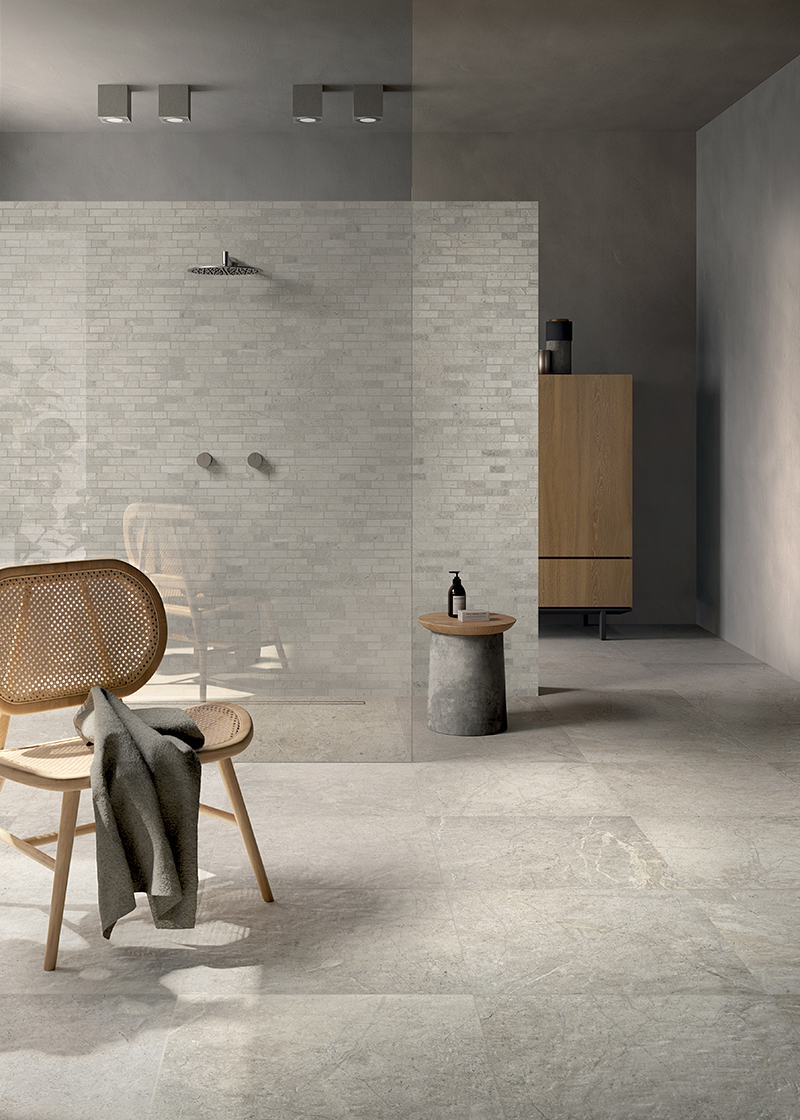
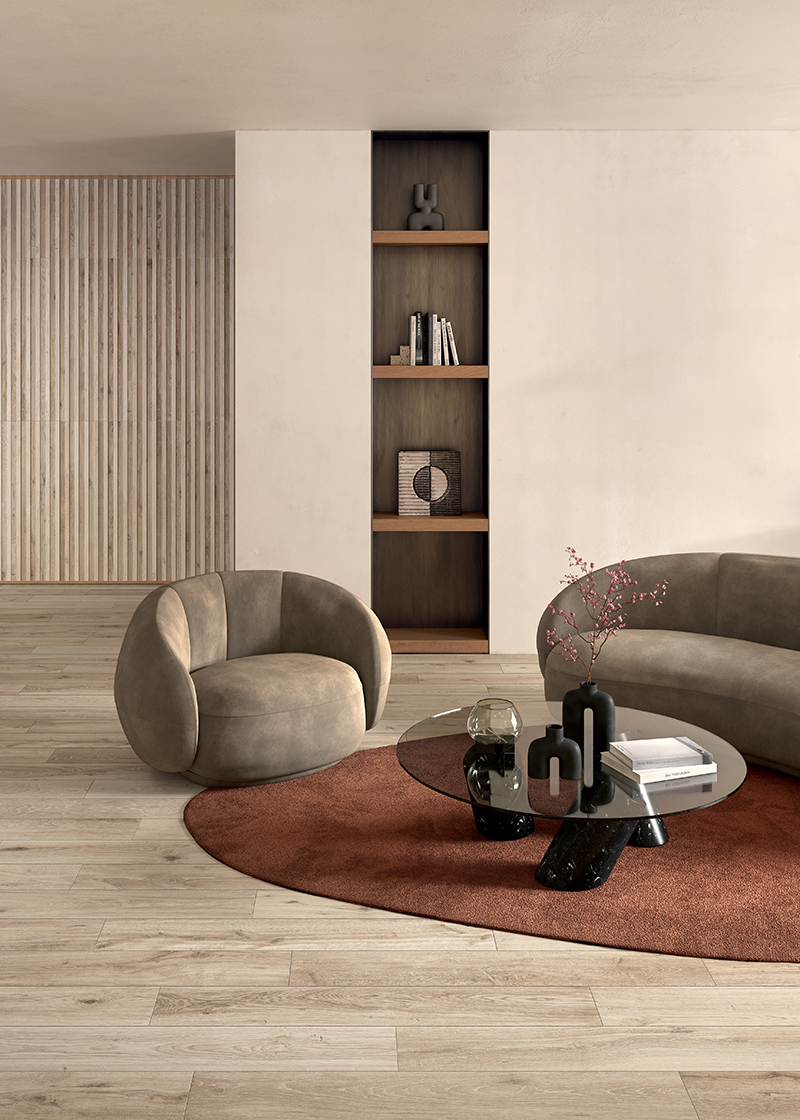
Solutions for Creating the Perfect Minimalist Living Room
A distinctive characteristic of minimalist style is the preference for open spaces. That’s why, in a minimalist living, it is important to maintain visual contact with the rest of the living area through the use of flooring and cladding. To this end, porcelain stoneware tiles become precious allies thanks to their adaptability, which allows for an extremely versatile range of applications.
In this environment as well, the recommended colour palette is limited to soft and neutral tones. Total white, grey, beige, and taupe, paired with pastel shades like antique pink, powder blue, or sage green help to create a more inviting atmosphere, maintaining the proper degree of sophistication.The selection can lean towards cement-look and stone-look products, classic choices for a minimal-chic style, while a bolder choice could be a warm wood-look tile.
Porcelain stoneware wood-look surfaces are able to offer a much simpler and cleaner appearance than natural wood, while replicating its grain and knots with an aesthetically pleasing balance of symmetries and colours.
Among Lea Ceramiche’s products, Bio Attitude manages to capture the true essence of oak, worn down by the passage of time and exposed to changing weather conditions. Its surfaces feature elegant graphics that consist of a blend of dark and almost-white fibres, resulting in exceptional optical balance and subtle variations in tone.
Elegantly Decorating a Minimalist-Style Living Room
To accentuate the essential furnishings of a minimalist living room, a sectional sofa, especially in an L-shaped configuration with a chaise longue, detachable seats, and poufs, is the undisputed protagonist. Alongside it, opt for lightweight glass or metal coffee tables and comfortable armchairs in fabric or faux leather. Along the perimeter of the room as well the choice of décor should be light: slim wall units and niches with built in shelving in the same colour as the walls so as to blend in.
Finally, if the living room is part of an open space with the dining room, a long narrow table can be used as a divider. This can also transform into a modern bar, complete with sleek bar stools and a set of pendant lamps.
The Must-Haves of Minimalist Decor in a Designer Home
In designing minimalist environments, even before one considers aesthetics, it is obviously crucial that each element add to the balance, order, and mental satisfaction of the space.
The cardinal rules of minimalist interior design could be summarised as follows:
- Exalt functionality and essential elements: light, shapes, and materials, preferably in an open floor plan, to create a sense of space and freedom;
- When it comes to aesthetics, favour simplicity, clean lines, and a neutral colour palette, which can be brightened up with the addition of a just a few select details;
- Embrace the mantra of “Less is more” by abandoning unnecessary decorations and superfluous ornaments and committing to a merciless decluttering process;
- Strive for a design that is clear and simple, yet never dull.
The key to a minimalist home is consistency, which means maintaining the same approach for every environment. This ensures that each room is designed and furnished harmoniously in relation to the others. In these austere environments, the focus is on the details: few in number, but visually striking.
If the furnishings in a minimalist home are reduced to the bare bones, it is fundamental that the materials be of the highest quality and, ideally, complement one another. This is where porcelain stoneware offers enormous benefits: a single cladding material that is able to adapt to various design styles, providing interiors with a powerful and creative tool.
Finally, an essential component of minimalist style is lighting. To contribute to the feeling of open space, an abundance of natural light is required. This, together with light and neutral colours, expands the perception of the space. For artificial lighting, minimalist pendant lamps or recessed spotlights are preferred, perfect for illuminating a room without weighing it down.
